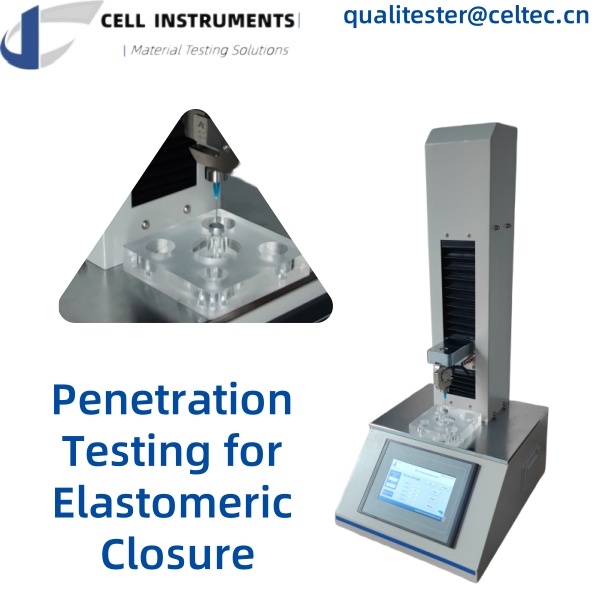Las pruebas de penetración para cierres elastoméricos desempeñan un papel fundamental para garantizar la seguridad y la fiabilidad de los envases farmacéuticos y médicos. Los cierres elastoméricos, que se utilizan habitualmente como tapones de goma para viales y otros dispositivos médicos, requieren pruebas rigurosas para cumplir con las normas de la industria, como la ISO 8871-5 y la USP 381. Estas normas garantizan que los cierres puedan mantener la esterilidad y la integridad de los productos médicos, especialmente cuando se someten a la penetración de agujas u otros dispositivos.
La importancia de las pruebas de cierre elastomérico en la industria farmacéutica
En la industria farmacéutica, mantener la integridad de los envases es esencial para evitar la contaminación y garantizar la eficacia de los medicamentos. Los cierres elastoméricos están diseñados para sellar los envases médicos de forma segura, evitando la entrada de aire o microorganismos. Sin embargo, también deben ser perforables por agujas para administrar medicamentos. Las pruebas de penetración ayudan a medir la resistencia de estos cierres para garantizar que las agujas puedan perforarlos de forma eficaz sin causar fragmentación ni comprometer el producto.
Comprensión de las normas ISO 8871-5 y USP 381
Ambos ISO 8871-5 y USP 381 Son normas clave que guían las pruebas de cierres elastoméricos.
- ISO 8871-5 Se centra en determinar las propiedades mecánicas de los cierres utilizados para envases de medicamentos parenterales, especificando los requisitos de los sistemas de cierre para garantizar un rendimiento constante en diferentes condiciones.

- USP 381 Proporciona pautas para la funcionalidad y seguridad de los materiales elastoméricos utilizados en los envases farmacéuticos. Describe los procedimientos de prueba para garantizar que los cierres sean seguros, no introduzcan contaminantes y mantengan una integridad de sellado adecuada cuando se perforan con agujas.
Estas normas garantizan que las pruebas de penetración se realicen de forma precisa y consistente, proporcionando a los fabricantes una forma confiable de evaluar el rendimiento de sus productos.
Cómo funcionan las pruebas de penetración
Las pruebas de penetración para cierres elastoméricos generalmente implican el uso de un instrumento especializado como el Probador de punción con aguja NPT-01 de Cell Instruments. Este dispositivo está equipado con varios tipos de agujas y plantillas para adaptarse a distintos tamaños y materiales de muestra. La prueba consiste en medir la fuerza necesaria para que una aguja perfore el cierre elastomérico, lo que proporciona datos sobre la resistencia a la perforación y la integridad del material.
El procedimiento de prueba sigue un proceso estandarizado:
- Se monta una aguja en la celda de carga del dispositivo.
- El cierre elastomérico se fija mediante un dispositivo fijo.
- La aguja se mueve a una velocidad controlada hasta perforar el cierre.
- Se registra la fuerza ejercida durante la punción para evaluar el rendimiento del cierre.
Estos datos ayudan a los fabricantes a garantizar que sus cierres sean lo suficientemente resistentes para mantener un sello seguro y lo suficientemente penetrables para un uso médico seguro.
Por qué es fundamental realizar pruebas de penetración adecuadas
Las pruebas de penetración precisas son cruciales por varias razones:
- Seguridad del paciente:Garantizar que los cierres se perforen correctamente sin introducir contaminantes es vital para prevenir la exposición del paciente a microorganismos dañinos.
- Integridad del producto:Las pruebas garantizan que los cierres mantienen sus propiedades protectoras después de ser perforados.
- Cumplimiento normativo:Seguir las pautas ISO 8871-5 y USP 381 garantiza que los productos cumplan con los estándares internacionales de seguridad, evitando retiradas costosas o sanciones regulatorias.
La función del comprobador de punción con aguja NPT-01 de Cell Instruments
El Probador de punción con aguja NPT-01 de Cell Instruments está diseñado específicamente para pruebas de penetración de cierres elastoméricos. Este versátil instrumento permite a los usuarios probar diversos materiales de cierre en diferentes condiciones, ofreciendo flexibilidad en tamaños de aguja y velocidades de prueba. Su mecanismo de tornillo de bola de precisión y su sistema de control avanzado garantizan resultados consistentes y repetibles, lo que lo convierte en una opción ideal para los fabricantes farmacéuticos.
Cumpliendo con ambos ISO 8871-5 y USP 381 Normas, la NPT-01 garantiza que los cierres elastoméricos cumplan con los requisitos de seguridad y rendimiento necesarios.
Las pruebas de penetración para cierres elastoméricos son esenciales para mantener la seguridad y la eficacia de los envases médicos. ISO 8871-5 y USP 381 estándares y utilizando instrumentos de prueba avanzados como el Probador de punción con aguja NPT-01Los fabricantes pueden garantizar que sus productos sean confiables y cumplan con las regulaciones internacionales.
Preguntas frecuentes
1. ¿Por qué son importantes las pruebas de penetración para los cierres elastoméricos?
Las pruebas de penetración garantizan que los cierres elastoméricos puedan perforarse de forma segura con agujas sin comprometer la esterilidad o integridad del contenedor, algo crucial para aplicaciones médicas y farmacéuticas.
2. ¿Qué normas rigen las pruebas de penetración de los cierres elastoméricos?
Las normas ISO 8871-5 y USP 381 proporcionan pautas para las propiedades mecánicas, la funcionalidad y la seguridad de los cierres elastoméricos utilizados en envases médicos.
3. ¿Cómo funciona el comprobador de pinchazos de aguja NPT-01?
El NPT-01 utiliza varios tipos de agujas y velocidades de prueba para medir la fuerza de punción necesaria para penetrar los cierres elastoméricos, lo que garantiza resultados de prueba confiables y precisos.
4. ¿Pueden las pruebas de penetración detectar defectos en cierres elastoméricos?
Sí, las pruebas de penetración ayudan a identificar debilidades en los cierres elastoméricos, como resistencia insuficiente a la perforación o potencial de fragmentación, garantizando la calidad y seguridad del producto.
5. ¿Qué industrias se benefician de las pruebas de penetración de cierres elastoméricos?
Las industrias farmacéutica, de dispositivos médicos y de embalaje se benefician de las pruebas de penetración, lo que garantiza que los cierres cumplan con los estándares de seguridad y rendimiento.

